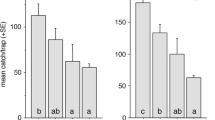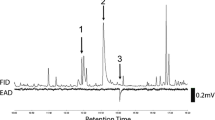Abstract
The guava moth, Coscinoptycha improbana, an Australian species that infests fruit crops in commercial and home orchards, was first detected in New Zealand in 1997. A four-component pheromone blend was identified but is not yet commercially available. Using single sensillum recordings from male antennae, we established that the same olfactory receptor neurons responded to two guava moth sex pheromone components, (Z)-11-octadecen-8-one and (Z)-12-nonadecen-9-one, and to a chain length analog, (Z)-13-eicosen-10-one, the sex pheromone of the related peach fruit moth, Carposina sasakii. We then field tested whether this non-specificity of the olfactory neurons might enable disruption of sexual communication by the commercially available analog, using male catch to synthetic lures in traps in single-tree, nine-tree and 2-ha plots. A disruptive pheromone analog, based on chain length, is reported for the first time. Trap catches for guava moth were disrupted by three polyethylene tubing dispensers releasing the analog in single-tree plots (86 % disruption of control catches) and in a plots of nine trees (99 % disruption). Where peach fruit moth pheromone dispensers were deployed at a density of 1000/ha in two 2-ha areas, pheromone traps for guava moth were completely disrupted for an extended period (up to 470 days in peri-urban gardens in Mangonui and 422 days in macadamia nut orchards in Kerikeri). In contrast, traps in untreated areas over 100 m away caught 302.8 ± 128.1 moths/trap in Mangonui and 327.5 ± 78.5 moths/ trap in Kerikeri. The longer chain length in the pheromone analog has greater longevity than the natural pheromone due to its lower volatility. Chain length analogs may warrant further investigation for mating disruption in Lepidoptera, and screening using single-sensillum recording is recommended.





Similar content being viewed by others
References
Anon (2013) http://www.iscatech.com/exec/DocLib/ISCA_Product_Label_-_SPLAT_EC.pdf. Accessed 24 June 2013
Barclay HJ, Matlock R, Gilchrist S, Suckling DM, Reyes J, Enkerlin WR, Vreysen MJB (2011) A conceptual model for assessing the minimum size area for an area-wide integrated pest management program. Int J Agron. doi:10.1155/2011/409328, Article ID409328
Bengtsson M, Liljefors T, Hansson BS, Lofstedt C, Copaja SV (1990) Structure-activity relationships for chain-shortened analogs of (Z)-5-decenyl acetate, a pheromone component of the turnip moth, Agrotis segetum. J Chem Ecol 16:667–684
Brockerhoff EG, Suckling DM, Roques A, Jactel H, Brancoe M, Twidle AM, Mastrom V, Kimberley MO (2013) Improving the efficiency of lepidopteran pest detection and surveillance: constraints and opportunities for multiple-species trapping. J Chem Ecol 39:50–58
Carlson DL, McLaughlin JR (1982) Diolefin analog of a sex pheromone component of Heliothis zea active in disrupting mating communication. Experientia 38:309–310
Curtis CE, Clark JD, Carlson DA, Coffelt JA (1987) A pheromone mimic - disruption of mating communication in the navel orangeworm, Amyelois transitella, with Z, Z-1,12,14-heptadecatriene. Entomol Exp Appl 44:249–255
Duero C, Camps F, Guerrero A (1995) Behavior of processionary males (Thaumetopoea pityocampa) induced by sex pheromone and analogs in a wind tunnel. J Chem Ecol 21:1957–1969
Dugdale JS (1988) Lepidoptera—annotated catalogue, and keys to family-group taxa. Fauna of New Zealand No.14, Entomol. Div, DSIR, vol 14. Auckland, New Zealand, p 262
Dymock JJ (2012) Biological control agents for the guava moth, Coscinoptycha improbana. Sustainable Farming Fund Project L11/145. 14pp. http://maxa.maf.govt.nz/sff/about-projects/search/l11-145/l11-145-report-biological-control-agents-guava-moth.pdf
El-Sayed AM (2013) The Pherobase. www.pherobase.com. Accessed 31 July 2013
Evenden ML, Judd GJR, Borden JH (1999) Mating disruption of two sympatric, orchard-inhabiting tortricids, Choristoneura rosaceana and Pandemis limitata (Lepidoptera: Tortricidae), with pheromone components of both species' blends. J Econ Entomol 92:380–390
Foster SP, Thomas WP (2000) Identification of a sex pheromone component of the raspberry budmoth, Heterocrossa rubophaga. J Chem Ecol 26:2549–2555
Gibb AR, Suckling DM, Morris BD, Dawson TE, Bunn B, Comeskey D, Dymock JJ (2006) Z7-Tricosene and monounsaturated ketones as sex pheromone components of the Australian guava moth Coscinoptycha improbana: identification, field trapping, and phenology. J Chem Ecol 32:221–237
Han KS, Jung JK, Choi KH, Lee SW, Boo KS (2000) Sex pheromone composition and male trapping of the peach fruit moth, Carposina sasakii (Matsumura) (Lepidoptera: Carposinidae) in Korea. J Asia Pac Entomol 3:83–88
Hoare RJB (2001) Adventive species of Lepidoptera recorded for the first time in New Zealand since 1988. New Zeal Entomol 24:23–47
Honma K, Kawasaki K, Tamaki Y (1978) Sex-pheromone activities of synthetic 7-alken-11-ones for male peach fruit moths, Carposina niponensis Walsingham (Lepidoptera: Carposinidae). Jpn J Appl Entomol Zool 22:87–91
Jamieson LE, Dymock JJ, Dawson T, Froud KJ, Dentener PR, Seldon DS, Gibb AR, Suckling DM (2004) The distribution, biology and hosts of guava moth in New Zealand. New Zeal Plant Prot 57:13–19
Kang Z (1995) Studies on the occurrence and appropriate time for chemical control of Carposina niponensis in Changchun region. J Jilin Agric Univ 17:22–26
Levine JM, D'Antonio CM (2003) Forecasting biological invasions with increasing international trade. Conserv Biol 17:322–326
Liljefors T, Thelin B, van der Pers JNC, Lofstedt C (1985) Chain-elongated analogues of a pheromone component of the turnip moth, Agrotis segetum. A structure-activity study using moelcular mechanics. J Chem Soc Perkin Trans II 1957–62
Liu C, Qu Z, Yan X (2002) Control techniques of Carposina niponensis Walshingham on jujube trees in northern Shannxi. Plant Prot Beijing 28:32–33
Lucas P, Renou M, Tellier F, Hammoud A, Audemard H, Descoins C (1994) Electrophysiological and field activity of halogenated analogs of (E, E)-8,10-dodecadien-1-ol, the main pheromone component, in codling moth (Cydia pomonella L.) J. Chem Ecol 20:489–503
Mafra-Neto A, de Lame FM, Fettig CJ, Munson AS, Perring TM, Stelinski LL, Stoltman LL, Mafra LEJ, Borges R, Vargas RI (2014) Manipulation of insect behavior with Specialized Pheromone and Lure Application Technology (SPLAT®). In: Beck J, Coats J, Duke S, Koivunen M (eds) Natural products for pest management. ACS Symposium Series; American Chemical Society, Washington, DC, in press
Minks AK, Cardé RT (1988) Disruption of communication in moths: is the natural blend really the most efficacious? Entomol Exp Appl 49:25–36
Mitchell ER, Jacobson M, Baumhover AH (1975) Heliothis spp. disruption of pheromone communication by (Z)-9-tetradecen-1-ol formate. Environ Entomol 4:577–579
Mizukoshi T (2006) Non-target species caught by synthetic sex pheromone trap of lepidopterous pests on apple trees in Hokkaido. Jpn J Appl Entomol Zool 50:231–239
Nasu Y (2012) New record of Carposina coreana Kim caught by synthetic sex pheromone trap for C. sasakii Matsumura in Japan (Lepidoptera: Carposinidae). Jpn J Appl Entomol Zool 56:65–67
Nasu Y, Tamashima K, Shibao M, Yoshimatsu S, Naito T (2010) Rediscovery of Carposina niponensis Walsingham and carposinids caught by synthetic sex pheromone trap for C. sasakii Matsumura in Japan (Lepidoptera: Carposinidae). Jpn J Appl Entomol Zool 54:115–126
Oku T (1993) Suppression of lepidopterous pest populations in apple orchards through mating disruption with synthetic sex pheromones. Jpn Agric Res Q 26:271–276
Park KC, Baker TC (2002) Improvement of signal-to-noise ratio in electroantennogram responses using multiple insect antennae. J Insect Physiol 48:1139–1145
Park KC, Hardie J (2004) Electrophysiological characterization of olfactory sensilla in the black bean aphid, Aphis fabae. J Insect Physiol 50:647–655
Roelofs WL, Cardé RT (1977) Responses of Lepidoptera to synthetic sex pheromone chemicals and their analogues. Annu Rev Entomol 22:377–405
Roelofs WL, Commeau A (1971) Sex pheromone perception: synergists and inhibitors for the red-banded leafroller. J Insect Physiol 17:435–448
Schmidt JO, Seabrook WD, Lonergan G, Oda T, Darvesh S, Valenta Z (1980) Effects of pheromone, pheromone components, and pheromone analogues on mating of the spruce budworm (Lepidoptera: Tortricidae). Can Entomol 112:605–608
Silk PJ, Kuenen LPS, Lonergan GC (1985) A biologically active analogue of the primary sex-pheromone components of spruce budworm, Choristoneura fumiferana (Lepidoptera: Tortricidae). Can Entomol 117:257–260. doi:10.4039/Ent117261-2
Suckling DM, Burnip GM (1996) Orientation disruption of Planotortrix octo using pheromone or inhibitor blends. Entomol Exp Appl 78:149–158
Suckling DM, McLaren GF, Manning LA, Mitchell VJ, Attfield B, Colhoun K, El-Sayed AM (2012) Development of single-dispenser pheromone suppression of Epiphyas postvittana, Planotortrix octo and Ctenopseustis obliquana in New Zealand stone fruit orchards. Pest Manag Sci 68:928–934
Tamaki Y, Honma K, Kawasaki K (1977) Sex pheromone of the peach fruit moth, Carposina niponensis Walsingham. (Lepidoptera: Carposinidae): isolation, identification and synthesis. Appl Entomol Zool 12:60–68
Todd JL, Millar JG, Vetter RS, Baker TC (1992) Behavioral and electrophysiological activity of (Z, E)-7,9,11-dodecatrienyl formate, a mimic of the major sex pheromone component of carob moth, Ectomyelois ceratoniae. J Chem Ecol 18:2331–2352
Tumlinson JH (1979) Recent discoveries in insect pheromone chemistry. In: Geissbuhler H, Brooks GT, Kearney PC (Eds) International Union of Pure and applied Chemistry: Advances in pesticide science. Symposia papers presented at the Fourth International Congress of Pesticide Chemistry. Zurich, Switzerland, July 24–28, 1978, pp315–322
Ujvary I, Dickens JC, Kamm JA, Mcdonough LM (1993) Natural product analogs - stable mimics of aldehyde pheromones. Arch Insect Biochem Physiol 22:393–411
Witzgall P, Kirsch P, Cork A (2010) Sex pheromones and their impact on pest management. J Chem Ecol 36:80–100
Xu P, Garczynski SF, Atungulu E, Syed Z, Choo Y-M, Vidal DM, Zitelli CHL, Leal WS (2012) Moth sex pheromone receptors and deceitful parapheromones. PLoS ONE 7:e41653. doi:10.1371/journal.pone.0041653
Acknowledgments
The Royal Society of New Zealand are gratefully acknowledged for the granting of a Teaching Fellowship to RHW based at Plant & Food Research. The Northland Regional Council funded the large-scale mating disruption trials with further support from Plant & Food Research (Sustainable IPM in Horticulture). We thank Jeff Cleghorn and Daehee Ahn who allowed pheromone dispensers and guava moth traps on their property. Asha Chhagan kindly assisted with field work, and Rikard Unelius helpfully reviewed the manuscript. Ed Stewart helped with synonyms and Barry Bunn synthesized the (Z7)-23Hy.
Author information
Authors and Affiliations
Corresponding author
Rights and permissions
About this article
Cite this article
Suckling, D.M., Dymock, J.J., Park, K.C. et al. Communication Disruption of Guava Moth (Coscinoptycha improbana) Using a Pheromone Analog Based on Chain Length. J Chem Ecol 39, 1161–1168 (2013). https://doi.org/10.1007/s10886-013-0339-3
Received:
Revised:
Accepted:
Published:
Issue Date:
DOI: https://doi.org/10.1007/s10886-013-0339-3




